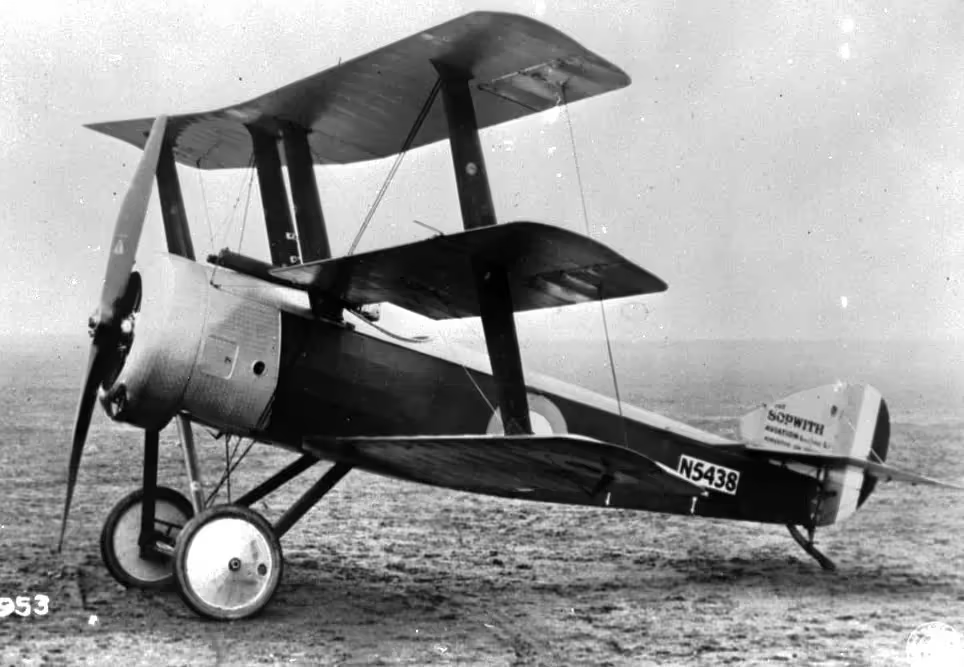Canadian Warplanes 1: Sopwith Triplane
Sopwith Triplane

(Library and Archives Canada Photo, MIKAN No. 3390963)
Sopwith Triplane (Serial No. N5438), ca 1918.
The Sopwith Triplane was a British single seat fighter aircraft designed and manufactured by the Sopwith Aviation Company during the First World War. It has the distinction of being the first military triplane to see operational service.
The Triplane was developed by the firm's experimental department as a private venture, the project was headed by the designer Herbert Smith. Aside from its obvious difference in wing configuration, the aircraft shared many similarities with the company's successful biplane fighter, the Sopwith Pup. The prototype Triplane performed its maiden flight on 28 May 1916 and was dispatched to the French theatre two months later, where it garnered high praise for its exceptional rate of climb and high manoeuvrability. During late 1916, quantity production of the type commenced in response to orders received from the Admiralty. During early 1917, production examples of the Triplane arrived with Royal Naval Air Service squadrons.
The Triplane rapidly proved to be capable of outstanding agility, and thus was quickly deemed to be a success amongst those squadrons that flew it. Praise for the type extended to opposing pilots; Imperial Germany extensively studied the Triplane via captured examples and produced numerous tri-winged aircraft shortly thereafter. Nevertheless, the Triplane was built in comparatively small numbers to that of the more conventional Sopwith Pup. It had been decided to withdraw the Triplane from active service as increasing numbers of the Sopwith Camel arrived in the latter half of 1917. Surviving Triplanes continued to serve as operational trainers and experimental aircraft until months following the end of the conflict.
The Sopwith Triplane was a single seat fighter aircraft; it shared a considerable amount of its design features, such as its fuselage and empennage, with those of the earlier Pup. The most distinctive feature of the Triplane is its three narrow-chord wings; these provided the pilot with an improved field of view. These wings had the exact same span as that of the Pup, while being only 21 square feet less in terms of area. Ailerons were fitted to all three wings. The relatively narrow chord and short span wings have been attributed with providing a high level of manoeuvrability. The introduction of a smaller 8 ft span tailplane in February 1917 was attributed with improved elevator response. The original tail assembly was identical to the Pup's, other than the inclusion of the variable incidence tailplane, which could be adjusted so that the aircraft could be flown hands-off. The Triplane was initially powered by the 110 hp Clerget 9Z nine-cylinder rotary engine. However, the majority of production examples were instead fitted with the more powerful 130 hp Clerget 9B rotary.
The Triplane's combat career was comparatively brief, in part because it proved difficult to repair. The fuel and oil tanks were inaccessible without dismantling the wings and fuselage; even relatively minor repairs had to be made at rear echelon repair depots. Spare parts became difficult to obtain during the summer of 1917. The Triplane also gained a reputation for structural weakness because the wings of some aircraft collapsed in steep dives. This defect was attributed to the use of light gauge bracing wires in the 46 aircraft built by subcontractor Clayton & Shuttleworth. Another drawback of the Triplane was its light armament. Contemporary Albatros fighters were armed with two guns but most Triplanes carried one synchronised Vickers machine gun. Efforts to fit twin guns to the Triplane met with mixed results. (Wikipedia)

(Early Aviator Photo)
Sopwith Triplane cockpit, ca 1917)

(RAF Photo)
Raymond Collishaw's Sopwith Triplane, (Serial No. N533), July 1917. Collishaw flew several Triplanes, all named "Black Maria".
18 May 1917. First flight of Canadian fighter pilot Raymond Collishaw's "B" Flight of Naval 10 would initially be composed entirely of Canadians, and would later be nicknamed the "Black Flight", owing to the flight's black (front) engine cowling and wheel covers (to contrast with the red and blue of Naval 10's "A" and "B" Flights, respectively). In addition, the flight decided to give their machines names in large (3-inch) white letters on either side near the cockpit. Ellis Vair Reid, of Toronto, Ontario flew Black Roger; John Edward Sharman, of Winnipeg, Manitoba flew Black Death; Gerald "Gerry" Ewart Nash, of Stoney Creek, Ontario flew Black Sheep; Marcus Alexander, of Toronto, flew Black Prince; and Collishaw chose Black Maria (a reference to a police van). During their first two months they claimed a record 84 German aircraft destroyed or driven down..

(DND Archives Photo, AH-493)
Sopwith Triplane, flown by Nos. 1, 8 and 10 Squadrons of the Royal Naval Air Service (RNAS). These squadrons were temporarily loaned to the Royal Flying Corps (RFC) in the preparations for the Battle of Vimy Ridge in 1917.

(RAF Photo)
Sopwith Triplane (Serial N5387), "Peggy", No. 1 Naval Squadron, ca. 1917.



(Author Photos)
Sopwith Triplane replica (Serial No. N5492), CF-CBM. The Museum's Triplane is a reproduction built by American amateur airplane-maker Carl R. Swanson between 1963 and 1966. The Museum purchased it in 1966, and provided and installed its Clerget 9B rotary engine. Wing Commander Paul A. Hartman piloted the aircraft during its first flight, on 5 May 1967 at Rockcliffe airport. It remained airworthy and flew on special occasions until 1971. (CA&SM)


(Author Photos)
Sopwith Triplane replica, Reg. No. N6302, The Hangar Flight Museum, Calgary, Alberta.

(Nick-D Photo)
Sopwith Triplane (Serial N5912) on display in the Grahame White Hangar, at the Royal Air Force Museum London, UK, 2011.

(Greg Goebel Photo)
Sopwith Triplane, Seattle Museum Of Flight, Washington.
_(6736566545).avif)
(Alan Wilson Photo)
Sopwith Triplane replica in flight, Shuttleworth Collection, UK.





